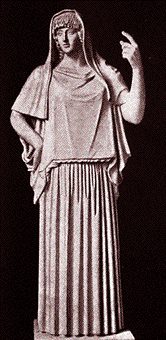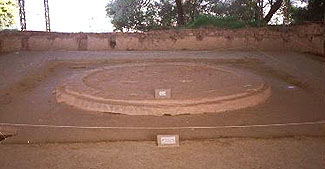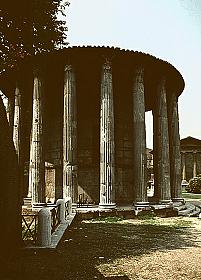 Roman Coin Showing Temple of Vesta with Chair and Urn |
 Featured
Diety
Featured
Diety ESTIA
ESTIA 
(Hestia)
 Roman Coin Showing Temple of Vesta with Chair and Urn |
 Featured
Diety
Featured
Diety ESTIA
ESTIA 
Harris and Platzner see her fixity as a symbol of the balance between the gods. Hestia stands at the opposite end of the spectrum from Hermes, who is constantly in motion and who ranges freely across the sky, the earth, and the underworld.
Prayers to the gods in general, both in times of stress and celebration, would both begin and end with Hestia--even before her brother Zeus--as she was the guardian of innermost things.
Plato, in a rather complicated but thoughtful passage, describes Socrates musing upon the possible origins of Hestia's name in his dialogue Cratylus 401c. Socrates suggests that "in ancient times we too seem to have said esia for ousia (reality), and this you may note to have been the idea of those who appointed that sacrifices should be first offered to estia, which was natural enough if they meant that estia was the essence of things."
Because of this mysterious nature of hers, it's very difficult to find images of Hestia, even though they are abundant for most of the other gods. Pausanias says in his Description of Greece 2.35.1 that at the temple of Hestia belonging to the city of Hermione, in Southeast Argolis, there is "no image, but only an altar, and they sacrifice to Hestia upon it." This appears to have been typical. When she is pictured, she generally looks like a modest matron, as in the statue of Hestia at the upper right of this page. It's actually a statue of her Roman counterpart, Vesta, because as far as we know the Greeks did not make freestanding statues of Hestia. When she is depicted in Greek vase paintings and relief sculptures, she is usually a part of a "group shot" where there is a gathering of the gods.
Yet despite this lack of representation, Hestia is extremely important. The fifth-century B.C. Greek historian Herodotus claims in his History 4.59.1 that Hestia was one of the very few goddesses acknowledged by the wild Scythians, who revered her under the name of Tabiti. This may be a false assertion that conflates Hestia with a different fire goddess altogether, like the false assertion that Io was worshipped as Isis or Hathor in Egypt, but I think it's an interesting story anyway.
Both Hesiod and Apollodorus acknowledge Hestia as the oldest of the Olympians, first-born child of the Titans Cronus and Rhea and, thus, the first of the children to be swallowed by Cronus. According to most accounts, the children were regurgitated in reverse order from their original birth, so I guess one might also call her the youngest of Cronus and Rhea's children... depending on whether you count from her birth, or from her first appearance on Earth.
Although according to the Homeric Hymn to Aphrodite both her brother Poseidon and her nephew Apollo wanted to marry her, Hestia swore an oath of virginity and extracted from Zeus a promise that he would never force her to wed. Instead of marriage, he gave her the place of honor in the very midst of the house and of the city.
Every hearth on earth was considered Hestia's altar, and when colonists left a city they would take with them some fire from her main altar (prytaneion) in their home town and use it to light the prytaneion fire in the new one. This fire must never be permitted to go out. I don't have any proof, but I have long suspected that our modern custom of transferring the Olympic flame from Greece for the games is actually based on this ancient practice. The Greeks themselves did not have a tradition of carrying the Olympic torch, of course, because they didn't have to convey the fire anywhere: the Olympic games were always held in the same place, every four years at Olympia.
On a more domestic scale, a newborn child had to be carried formally around its household's hearth--an acknowledgement of the baby's legitimacy--before it could be accepted into the family.
In Laws 5.745b (book 5, section 745), Plato says that as soon as a new city is founded, its founder "must divide off twelve portions of land,--when he has first set apart a sacred glebe for Hestia, Zeus and Athena, to which he shall give the name 'acropolis' and circle it round with a ring-wall." In 8.848d of that same text, he says that "everywhere we shall erect temples to Hestia and Zeus and Athena, and whatever other deity is the patron of the district concerned."
It makes sense that she shows up in Plato's Laws, because Hestia also had a strong connection with the law. Judges were required to promise in her name to give the fairest judgments of which they were capable, and the prytaneion was the headquarters of the standing committee of the Athenian senate. There was also an altar to Hestia in the senate house. Aeschines, in his On the Embassy, describes her as "goddess of the senate."
Hestia is also mentioned in the Homeric Hymns, albeit some of the shorter ones. The first of these hymns to Hestia (24) describes her in a rather evocative manner, for a goddess of fire:
 |
And you, Slayer of Argus, Son of Zeus and Maia,
messenger of the blessed gods, bearer of the golden rod, giver of good,
be favorable and help us, you and Hestia, the worshipful and dear.
Come and dwell in this glorious house in friendship together;
for you two, well knowing the noble actions of men, aid on their wisdom and
their strength.
Hail, Daughter of Cronos, and you also, Hermes, bearer of the golden rod!
Now I will remember you and another song also.
 Hestia's Roman counterpart, Vesta, was an individual of much more presence and political
importance than the quiet Greek goddess who stepped down from her throne on Olympus when
Dionysus came on the scene, to preserve the order and the number of major Olympians in the
pantheon. The Greeks saw Hestia as a modest homebody with no political ambition; the Roman
Vesta, like the Roman women, was an important feature in public life.
Hestia's Roman counterpart, Vesta, was an individual of much more presence and political
importance than the quiet Greek goddess who stepped down from her throne on Olympus when
Dionysus came on the scene, to preserve the order and the number of major Olympians in the
pantheon. The Greeks saw Hestia as a modest homebody with no political ambition; the Roman
Vesta, like the Roman women, was an important feature in public life.
Vesta's distinctive circular temple in the Roman Forum, pictured to the left, was tended by six Vestal Virgins chosen from prominent families. Beginning as young girls, the Vestals served in the temple for thirty years, during which time they were sworn to strict chastity on pain of being buried alive. This was no idle threat; there are historical records of Vestals who paid this penalty, including the mythological account of the mother of Romulus and Remus, the founders of Rome itself. I can't tell you her name, because varying accounts call her Ilia, Rhea, or Silvia, but the story goes that she was seduced or raped by Mars, god of war, and bore him twins. Since being buried alive kept her from raising her two boys, they were exposed and were suckled by a she-wolf.
With the exception of that one prohibition, the Vestal Virgins enjoyed considerably more freedom than most women of Rome--or, for that matter, any women in the ancient world. They enjoyed the best seats at public events and were treated as V.I.P.s at celebrations and private parties, and their political power was considerable. If a condemned man met a Vestal Virgin in the street on his way to his execution, he was issued an automatic pardon (you can imagine how tempting it would be to use one's power and "accidentally" run into someone whose life you wanted to save).
The senior Vestal was a force to be reckoned with in any decision of the Senate or even the Caesars, since she represented the will of the goddess who was the very center or essence of the city. Vesta was not the patron goddess of Rome--that honor was reserved for Venus, as mother of Aeneas--but she personified its spirit.
After her thirty-year term of service, a Vestal Virgin was free to pursue a profession or even marry if she chose to do so. There is, however, no historical record of any Vestal Virgin who chose the marriage route, so that seems to be a sign that they must have enjoyed their independence and power and that the Vestal Virgin lifestyle was highly desirable.
Unfortunately, there is plenty of evidence for several occasions where Vestal Virgins
broke their vows of chastity, so apparently the Virgin part wasn't as attractive as the rest of
the package. In the reign of the Emperor Domitian, three of the Vestal Virgins were put to
death in a single year (83 A.D.), and the Chief Vestal Virgin, herself,
entered the burial room on the same pretext seven years later. This was probably due to a political
disagreement with the Emperor rather than a sudden rash in lecherous behavior on the part of the Vestals.

Vesta's name has been remembered in various
products and inventions, such as the "vesta match" that enjoyed some popularity in the 1870s (a miniature wax
or stearine candle tipped with a match head--try a search for "vesta" on EBay
and you will get an enormous number of hits for gorgeous decorative vesta cases). Ebay also offers us the opportunity to purchase Vesta Ritual Powder: according to one page I looked at, this is a Wiccan remedy that will "clear the premises quickly of
all evil spirits, to cease harmful gossip or whatever special intentions are requested of Vesta. When used as a sachet, it is said to help present the illusion of the wearer`s youthfulness, purity and innocence," clearly a real deal at only about two dollars an ounce!

Vesta was also the name for a now-defunct brand of stove marketed by Frigidaire/Electrolux in the first half of the twentieth century, and an annual award for hearth and fireplace products. This year's page advertising the contest isn't nearly as good as last year's: the photo of the goddess with her trusty laptop computer propped up on a Doric pillar is a must-see.
For more information on the Hestia, click here for her entry from the Encyclopedia Mythica, and here for Carlos Parada's (very short!) overview of mythology surrounding Hestia in capsule form.